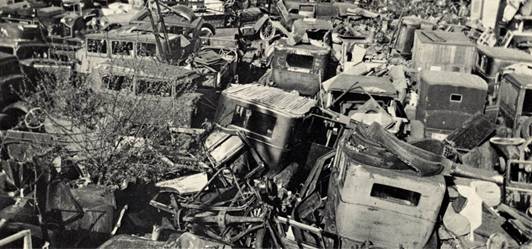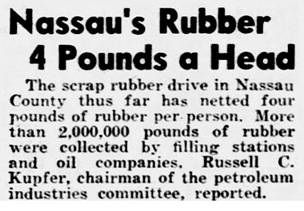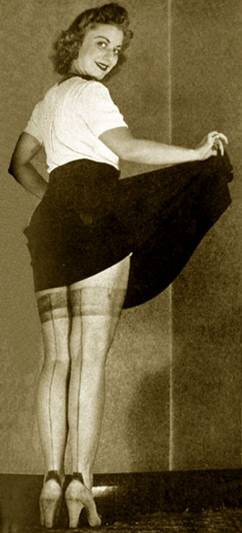Scrap Drives
I would not be surprised to learn that the phrase "Reduce, Re-use, Recycle" was first uttered during an ancient war by some now-anonymous Hittite or Assyrian ruler, who desperately needed to melt down some kettles and have them forged into swords (or, on another day, into plowshares).
I know of two abundant sources of scrap steel in Hicksville which were plundered during World War II. Beneath the paving of West John Street and a small portion of Broadway, nearly forgotten, lay the rails once used by the trolleys of the New York and North Shore. The other source, on Barclay Street, and famous in the automotive world because of the classics and the racing cars that emerged from it, was Mike Caruso's scrap business.
Caruso junkyard in 1937, before the advent of wartime scrap drives
The Bulb Horn, January-February 1964 issue
Most scrap drives were appeals to individuals, urging them to relinquish things which might be collecting dust and rust in their homes and garages. School groups and Scouts proved especially adept at running such drives.
Metals were a prime target, although behind the scenes, the efficacy of recycling certain metals for the war was questioned. The recycling of iron and steel long had been recognized as effective, and in wartime, it became more so, as it reduced the nation's need to mine, ship, and process ore. Brass - ideal for making ammunition - was in high demand and short supply, so recycling it made sense. In contrast, aluminum recycling proved both more difficult and less effective.
The dire need for rubber triggered scrap drives for old rubber items: electrical insulators, rubber balls, bicycle and automobile tires, rubber dolls, girdles, even hot water bottles. The wartime public's cooperation was enthusiastic.

New York Daily News, July 17, 1942
There was, however, an unpublicized problem, one which still vexes environmentalists. Old rubber cannot really be turned into a replacement for new rubber. You cannot, say, melt down old tires and turn the resulting glop into new tires - which is precisely what government wanted scientists to find a way to do in the 1940s. For a while, they tried revitalizing rubber by grinding it up and mixing it with petroleum to make new tires, but the results were unsatisfactory.
Paper recycling was far more effective, and it helped the war effort by letting loggers concentrate more on cutting down trees for wood-frame construction. Rags also were collected, so that their fibers could be reused.
This is a good point at which to note that certain fabrics were unavailable to people on the Home Front. Silk, which primarily originated in Japan and in other places then under Japanese control, was obviously one. Another was nylon, then a new product, which was being used exclusively by the military, mostly for parachutes. The lack of these two fibers meant that, even for formal occasions, American women had no decent hosiery to wear. In consequence, a common wartime practice was for women to cover their legs with foundation makeup, and then paint or draw (sometimes with a friend's help, and usually using eyebrow pencil) mock hosiery seams up the rear of their calves, or beyond. Some stores even provided leg-painting salons!

Painted Lady: unusually elaborate painted-on hosiery
(no garter belt needed!)
https://www.perfumepassage.org/news/paint-hosiery-during-war-years
For today's generations, perhaps the most surprising scrap recycling effort of the war was the widespread collection of fats left over from household cooking. As explained to Pluto and Minnie Mouse in the Disney cartoon at this URL:
https://www.youtube.com/watch?v=Z4497GEGOOg, kitchen fat could be saved at home in a can. When the can was full, it could be taken to a local butcher or grocer in exchange for cash. You were paid (modestly) for saving it. Why? Because fats were used to make the glycerine compounds needed to manufacture explosives!
***
This is where we pause until next month - when we will discuss bullets made in Hicksville that may or may not have been defective, how to put a pen in the pocket of your Army uniform without breaking regulations, why you might need to buy a special ink to write your wartime letters, and lots of other stuff.
Stay tuned!
*****

